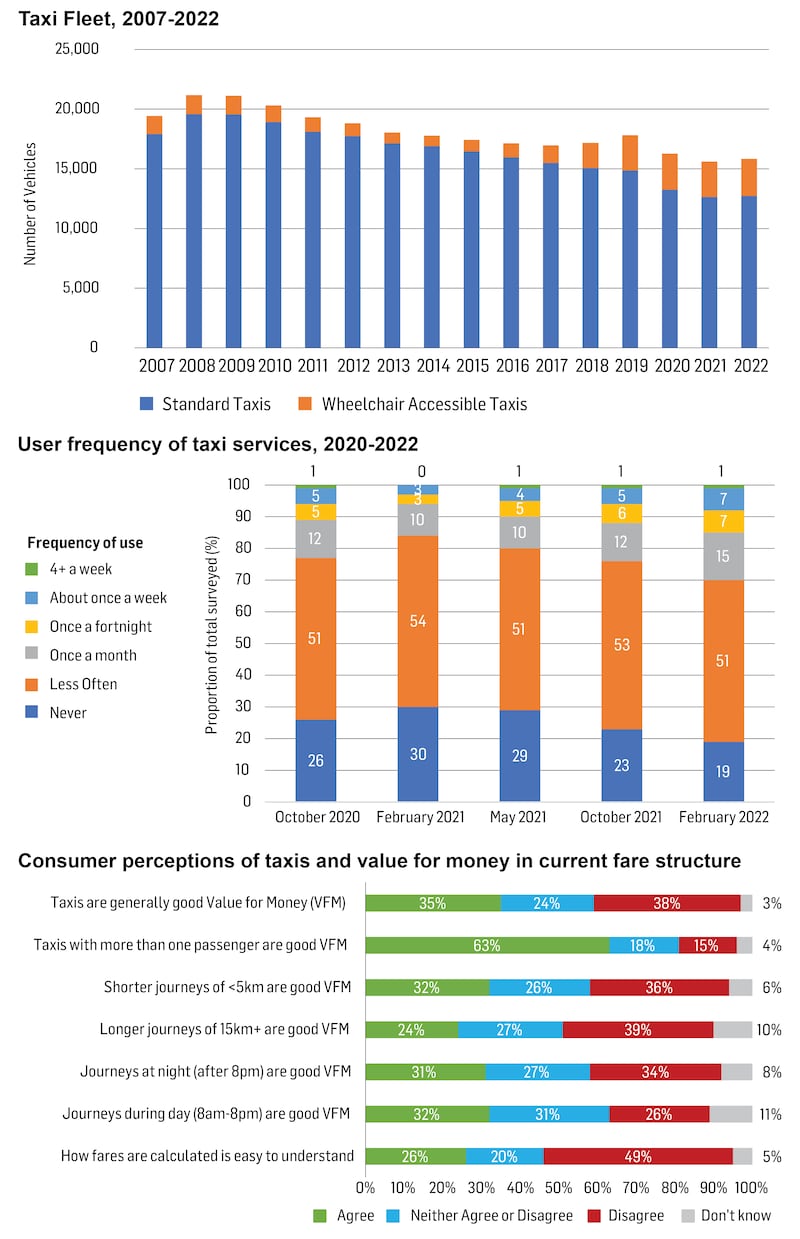Taxi drivers unsuccessfully sought permission for a 10 per cent “emergency fuel charge” as part of a forthcoming fare increase to reflect the rising cost of petrol and diesel.
Drivers are to receive a 12 per cent rise from next month, reflecting the change in running costs and overheads since 2017. A previously scheduled increase was postponed due to the pandemic.
More than 500 public submissions were filed with the National Transport Authority (NTA), which regulates the industry, overwhelmingly in support of the move.
However, disquiet remains among many drivers who fear the timing will repel customers in an era of steep inflation, and as the country faces into a winter of inflated energy prices.
READ MORE
“Some submissions expressed concern that the effect of the increase would deter customers from taxis to cheaper modes of transport,” an NTA report on its consultation process noted.
“These respondents mentioned a decrease in fares would entice customers to use taxis.”
Under the regulations, only maximum fares are set and drivers are free to reduce prices.
Of 541 submissions received, 81 per cent were in agreement with the proposed Maximum Fares Order. Fewer than one in five disagreed (17 per cent). More than two-thirds of received submissions were from or on behalf of taxi drivers.
[ ‘I still haven’t lost my fear of unemployment after all these years’Opens in new window ]
[ ‘We didn’t ask for it’: Apprehension among taxi drivers over fare increaseOpens in new window ]
[ Taxi driving: ‘Now I’m deciding where I’m going to park’Opens in new window ]
In commentary, those working in the industry flagged fuel and operating expenses, as well as the cost of living generally, more than any other issue.
The Irish Taxi Drivers Federation (ITDF) sought a temporary measure to help offset soaring fuel costs it said had spiked 33 per cent by the end of March.
“[We] propose to allow an emergency charge for example €1 to be added on to a €10 fare and €2 to a €20 fare. This is a 10 per cent emergency fuel charge,” it said, arguing the NTA had already set precedent in this area.
An NTA spokesman explained, however, that the 12 per cent hike reflects several factors including fuel costs.
“Proposals for what would amount to surge pricing in the taxi sector are not permitted at law and so are not part of the Maximum Taxi Fare Order,” he said.
Bolt, the taxi-hailing app that launched in Ireland in 2020, spoke of “the need to address the maximum fare levels to bring Dublin and, therefore the rest of the country, into line with peer cities”.

Criticism of fare increase
However, effects on passengers were also raised. The National Disability Authority (NDA) said that in the absence of a mobility allowance, “this increase in fares may result in increased social isolation, deprivation, and health impacts for persons with disabilities”.
Ireland has approximately 3.2 taxis per 1,000 people, rising to seven in Dublin. By comparison, the UK has 1.2 taxis per 1,000, according to NTA data. At 3.7 per 1,000 population, the number here of small public service vehicles (SPSVs), a broader category, far exceeds that in most of the EU with the average across western Europe standing at 1.3. Only in the UK, which has 4.4 SPSVs per 1,000 population is there a greater level of supply. Still, much commentary has focused on a perceived shortage, notably in the capital and there is some hope the new fare regime will coax more drivers out at peak times.
Dublin Town, the business improvement district, supports a premium rate for drivers in less sociable hours. “Customers are complaining of the unavailability of taxis late at night and [the] impact that this has on their ability get home safely,” it said in its submission.
The fare review, brought in under the Taxi Regulation Act 2013, updates the Taxi Cost Index, or those costs associated with driving a cab.
It is estimated that between 2017 and 2022, these have risen by as much as 11.5 per cent, based on data from the Central Statistics Office.
Including a provision for incoming cashless payment systems, the recommended 2022 maximum fare increase was settled at 12 per cent. A similar public consultation process in Northern Ireland was launched this month.









